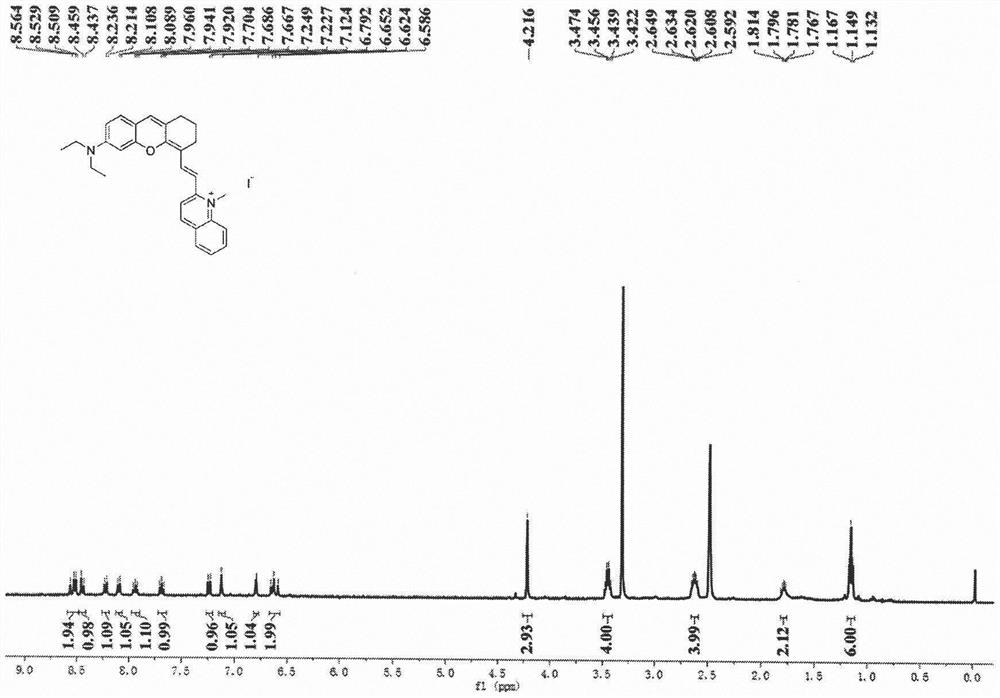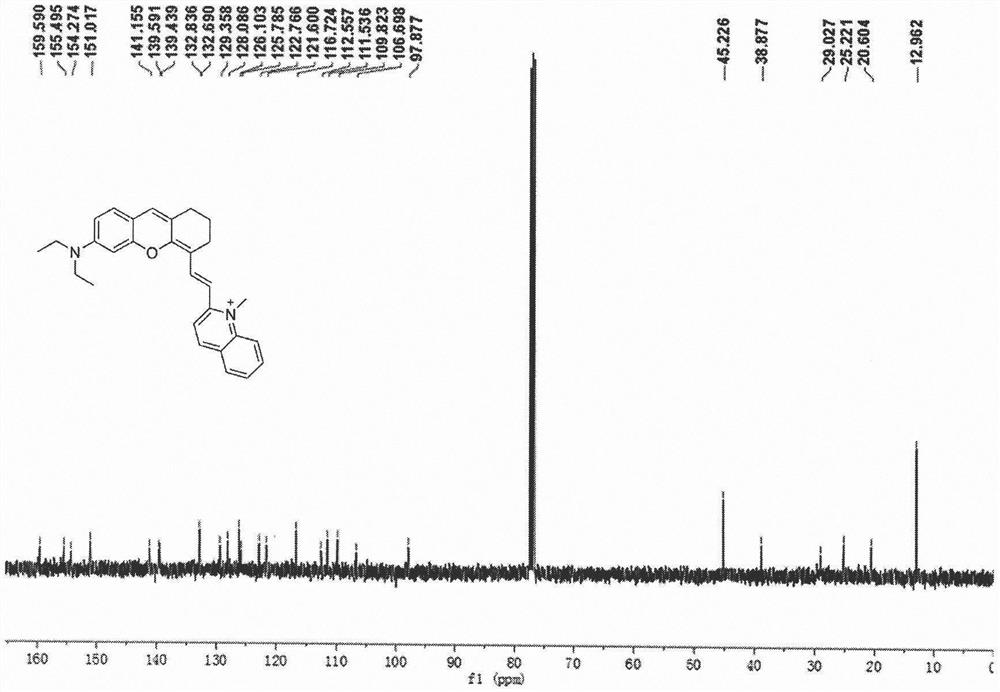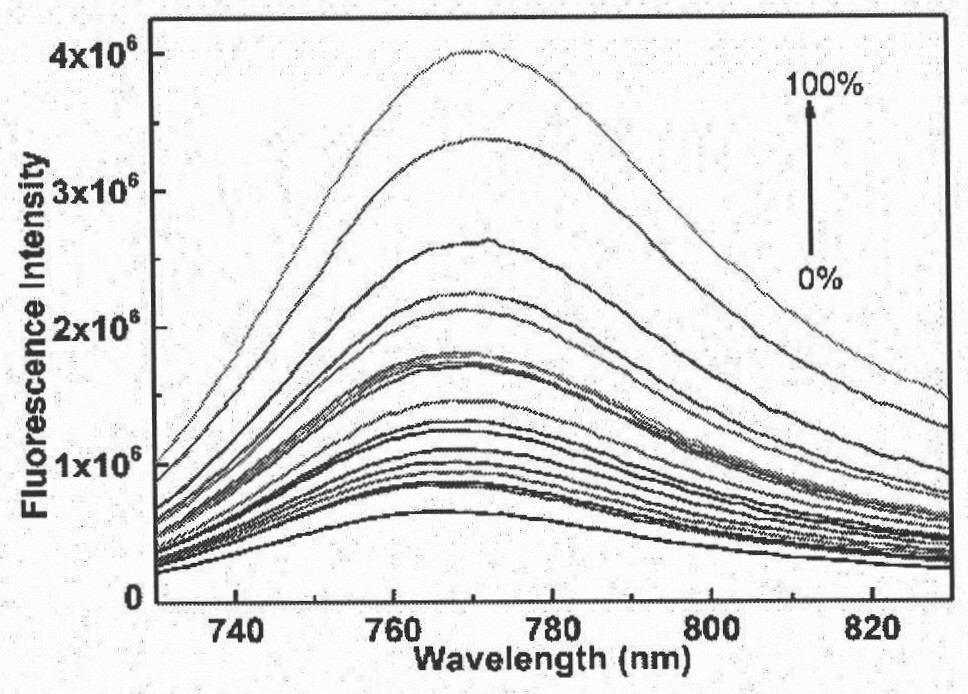Preparation and application of near-infrared viscosity fluorescent probe
A viscosity and probe technology, applied in fluorescence/phosphorescence, luminescent materials, material analysis through optical means, etc., can solve the problems of cell background fluorescence interference, etc., and achieve the effect of simple synthesis path and easy application
- Summary
- Abstract
- Description
- Claims
- Application Information
AI Technical Summary
Problems solved by technology
Method used
Image
Examples
Embodiment 1
[0025] Embodiment 1: the synthesis of probe M550
[0026]
[0027] Synthesis of compound 1: DMF (2.6 mL, 33.9 mmol) and 10.0 mL CHCl were added to a 50 mL round bottom flask 3 , after stirring at 0°C for 15 min, slowly add PBr at this temperature 3 (2.7 mL, 28.2 mmol), and after stirring for another 45 min, cyclohexanone (2.0 mL, 19.2 mmol) was added. The reaction solution was naturally warmed to room temperature and reacted for 16 h. Stop the reaction, pour the resulting red reaction solution into ice, add solid NaHCO 3 Adjust pH=7. Separate the organic layer and wash the aqueous layer with 30.0 mL CH 2 Cl 2 Extract three times and combine the organic layers. Washed three times with saturated NaCl solution, anhydrous NaCl 2 SO 4 After drying, the solvent was distilled off under reduced pressure to obtain a crude product. The crude product was separated and purified by column chromatography (ethyl acetate / n-hexane=1 / 8, v / v) to obtain Compound 1 as a colorless oil. ...
Embodiment 2
[0031] Example 2: Sensitivity of Probe M550 to Viscosity
[0032] The probe M550 in Example 1 was dissolved in DMSO to prepare a stock solution with a concentration of 2 mM. Take 10 μL of the above mother solution and add 2 mL of different volume ratios (ethanol:glycerol=90:10; 80:20; 70:30; 60:40; 50:50; 40:60; 30:70; 20:80; 10:90 ) in the ethanol / glycerin system, and then perform fluorescence detection, the results are shown in the attached image 3 : attached by image 3 It can be seen that with the increase of glycerol volume specific gravity, the fluorescence intensity of the probe increases gradually. This shows that the probe M550 can have a good response to the viscosity in the glycerol system.
Embodiment 3
[0033] Example 3: Mitochondrial colocalization of probe M550
[0034] The probe M550 in Example 1 was made into 1 mM mother solution with DMSO. Before the cell imaging experiment, first discard the supernatant in the culture dish, wash the cells carefully with PBS buffer three times, and then add the probe at a final concentration of 5 μM. The needle M550 was incubated at 37° C. for 30 min, then 1.0 μM Mito-Tracker Green FM was added, and the incubation was continued for 15 min, and then the cells were washed three times with fresh PBS (10 mM). By confocal laser scanning fluorescence microscopy, it was detected whether the probe M550 was localized in the mitochondria of cells. For probe M550, use 637nm laser as excitation light source, use red channel (730-800nm) to collect emission spectrum; for Mito-Tracker Green FM, use 488nm laser as excitation light source, use green channel (500-550nm) Collect emission spectra. Confocal fluorescence microscopy images such as Figure 4...
PUM
 Login to View More
Login to View More Abstract
Description
Claims
Application Information
 Login to View More
Login to View More - R&D
- Intellectual Property
- Life Sciences
- Materials
- Tech Scout
- Unparalleled Data Quality
- Higher Quality Content
- 60% Fewer Hallucinations
Browse by: Latest US Patents, China's latest patents, Technical Efficacy Thesaurus, Application Domain, Technology Topic, Popular Technical Reports.
© 2025 PatSnap. All rights reserved.Legal|Privacy policy|Modern Slavery Act Transparency Statement|Sitemap|About US| Contact US: help@patsnap.com



